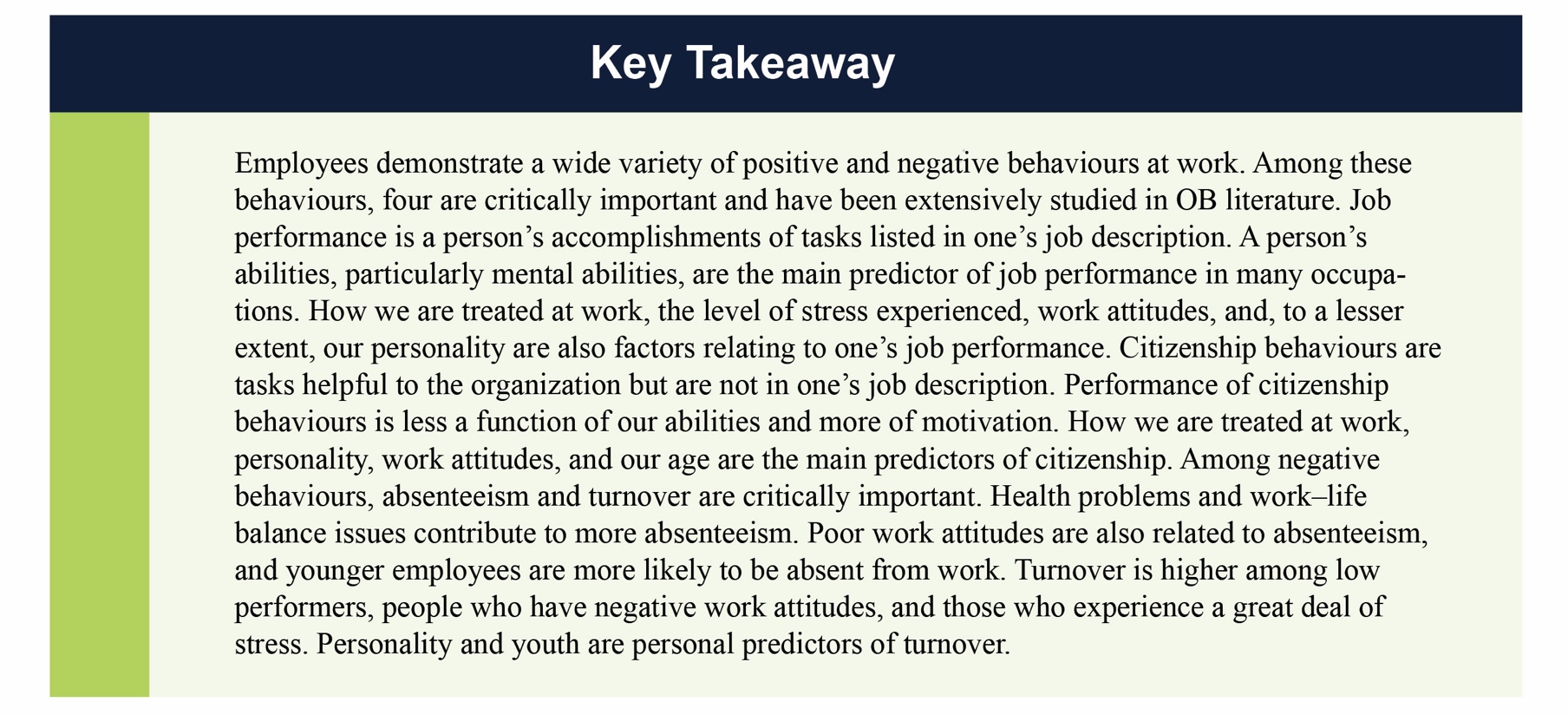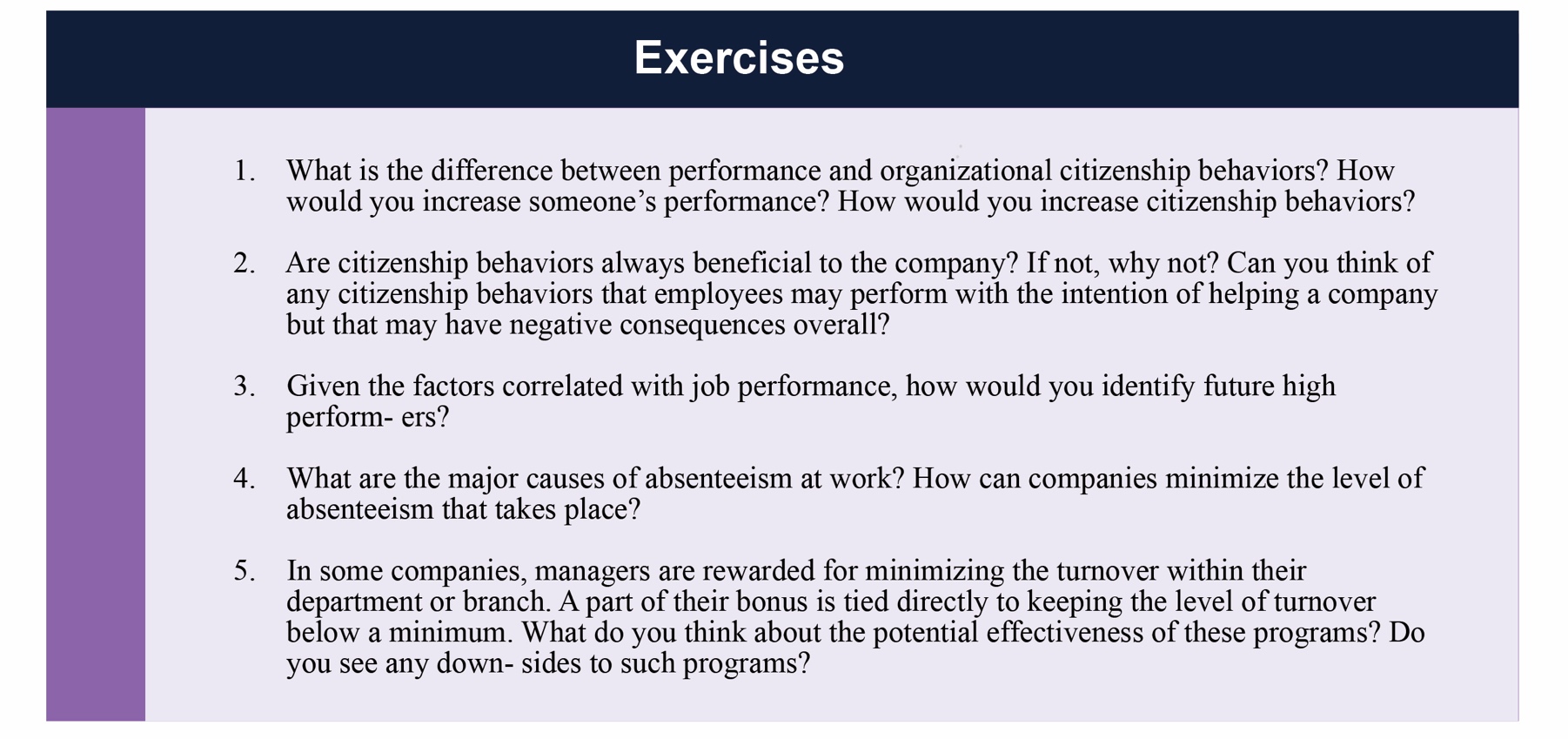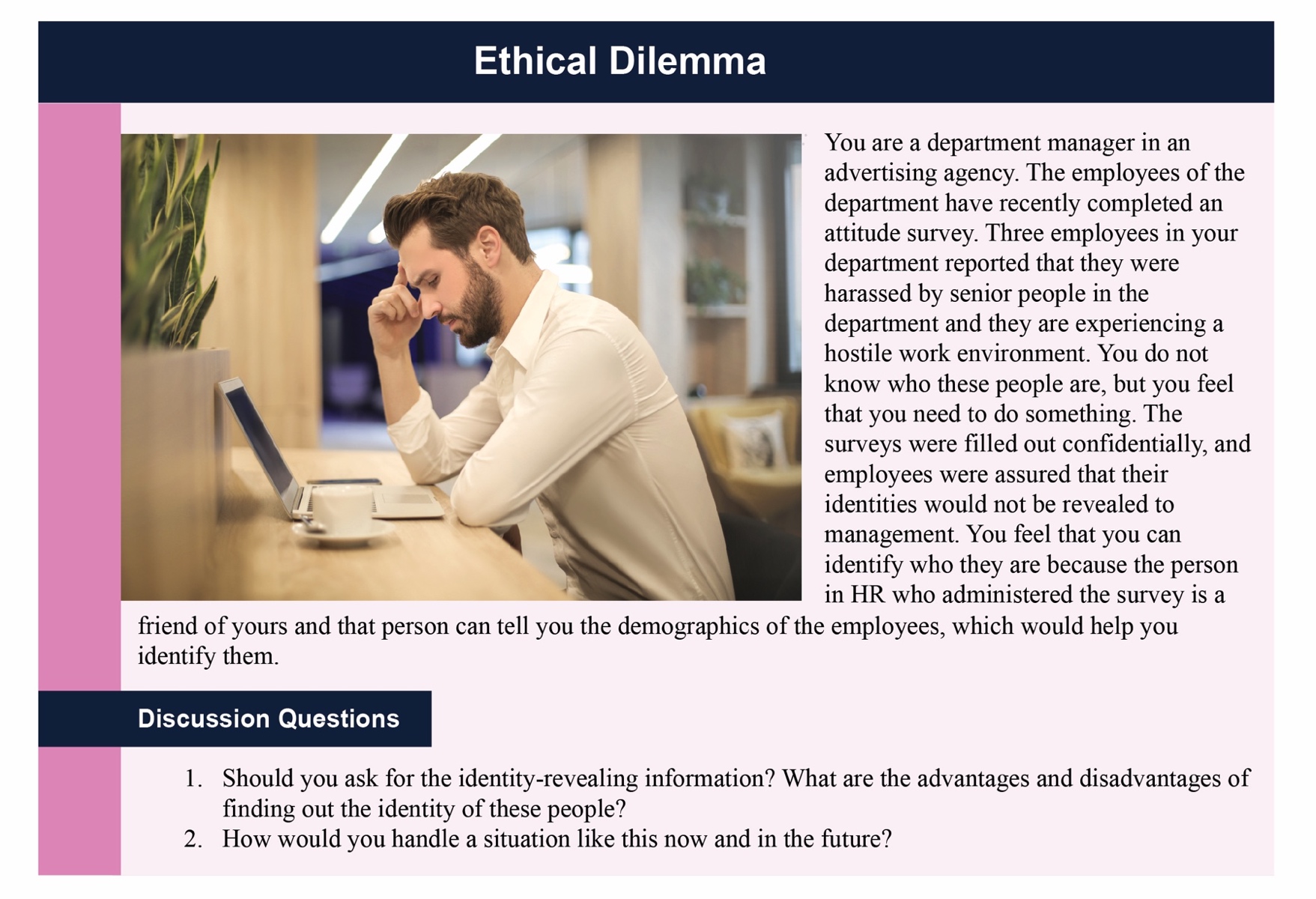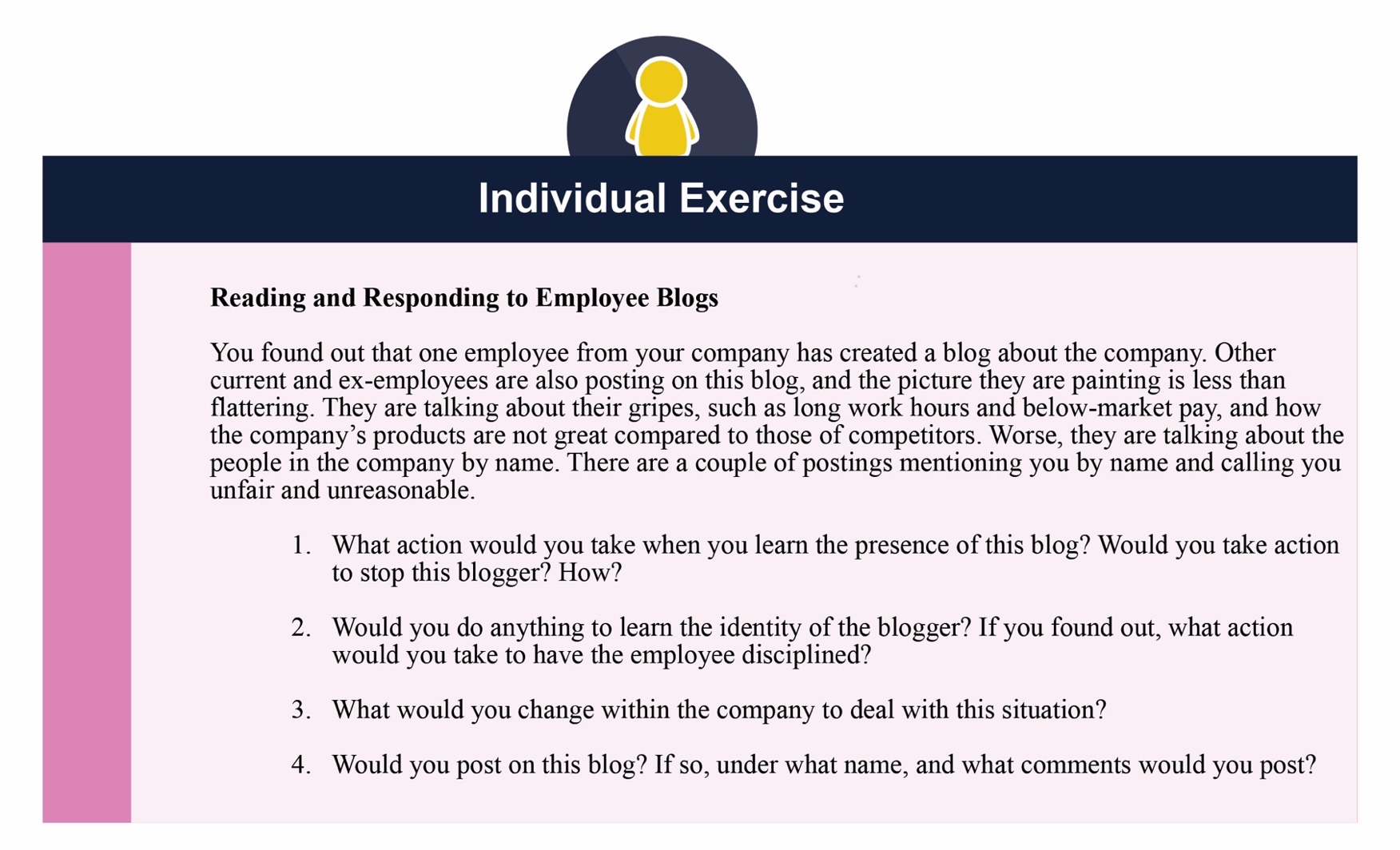Chapter 4: Individual Attitudes and Behaviours

Chapter Learning Outcomes
After reading this chapter, you should be able to know and learn the following:
- Define “work attitudes”.
- Define and differentiate between job satisfaction and organizational commitment.
- List the factors related to job satisfaction and organizational commitment.
- Describe the consequences of job satisfaction and organizational commitment.
- Define job performance, organizational citizenship, absenteeism, and turnover.
- Explain factors associated with each type of work behaviour.
Introduction
What Makes a Great Place to Work?
Every year, Great Place to Work Canada analyzes comments from thousands of employees and compiles a list of “The 100 Best Companies to Work for in Canada,” which is published in Fortune , a leading business magazine. Having compiled its list for more than twenty years, the institute concludes that the defining characteristic of a great company to work for is trust between managers and employees. Employees overwhelmingly say that they want to work at a place where employees “trust the people they work for, have pride in what they do, and enjoy the people they work with.” They report that they’re motivated to perform well because they’re challenged, respected, treated fairly, and appreciated. They take pride in what they do, are made to feel that they make a difference, and are given opportunities for advancement.
Ryan, a leading global tax services and software provider, has recently been named to the 2022 list of Best Workplaces
in Canada. This marks the 10th consecutive year Ryan has been recognized as one of Canada’s premier companies for building and maintaining high-trust, high-performance cultures that enhance business results and quality of work life. Ryan has offices in Alberta, British Columbia, Ontario, Quebec, and Saskatchewan.
“Earning a spot on the list of Best Workplaces in Canada for 10 consecutive years is a testament to the industry-leading culture we have created at Ryan,” said Ryan President of Canadian Operations Garry Round. “I appreciate our dedicated Canadian team members for their ongoing efforts in creating a positive environment that inspires us to want to be great for each other and our clients. This recognition further demonstrates our belief that a work environment built on trust leads to strong growth and financial success.”
4.1 People Come First: The Case of SAS

Who are your best customers? Which customers are bringing you the most profits and which are the least profitable? Companies are increasingly relying on complicated data mining software to answer these and other questions. More than 92% of the top 100 companies on the Fortune Global 500 list are using software developed by SAS Institute Inc., the world’s largest privately held software company, for their business intelligence and analytical needs. The Cary, North Carolina, company is doing extremely well by any measure. They have over 10,000 employees worldwide, operate in over 100 countries, and reported $2.31 billion in revenue in 2009 (their 33rd consecutive year of growth and profitability). The company is quick to attribute their success to the performance and loyalty of their workforce. This is directly correlated with how they treat their employees.
SAS has perfected the art of employee management. It has been ranked on Fortune magazine’s best places to work list every year since the list was first published. Employees seem to genuinely enjoy working at SAS and are unusually attached to the company, resulting in a turnover rate that is less than 4% in an industry where 20% is the norm. In fact, when Google designed their own legendary campus in California, they visited the SAS campus to get ideas.
One thing SAS does well is giving its employees opportunities to work on interesting and challenging projects. The software developers have the opportunity to develop cutting-edge software to be used around the world. The company makes an effort to concentrate its business in the areas of analytics, which add the most value and help organizations best analyze disparate data for decision making, creating opportunities for SAS workers to be challenged. Plus, the company removes obstacles for employees such as equipment, policies, rules, and meetings that could impede productivity.
The company has a reputation as a pioneer when it comes to the perks it offers employees, but these perks are not given with a mentality of “offer everything but the kitchen sink.” There is careful thinking and planning behind the choice of perks the company offers. SAS conducts regular employee satisfaction surveys, and any future benefits and perks offered are planned in response to the results. The company wants to eliminate stressors and anything that dissatisfies from people’s lives. To keep employees healthy and fit, there are athletic fields; a full gym; a swimming pool; and tennis, basketball, and racquetball courts on campus. Plus, the company offers free on-site health care for employees, covers dependents at their fully staffed primary medical care center, and offers unlimited sick leave. The company understands that employees have a life and encourages employees to work reasonable hours and then go home to their families. In fact, a famous motto in the company is, “If you are working for more than 8 hours, you are just adding bugs.” SAS is truly one of the industry leaders in leveraging its treatment of people for continued business success (Doing well by being rather nice, 2007; Florida & Goodnight, 2005).
4.2 Work Attitudes

Picture: efront
Our behaviour at work often depends on how we feel about being there. Therefore, making sense of how people behave depends on understanding their work attitudes.
An attitude refers to our opinions, beliefs, and feelings about aspects of our environment and your response to events, situations, people, and yourself. We have attitudes toward the food we eat, people we interact with, courses we take, and various other things. Attitude is therefore the way you look at life. Your attitude is not something that happens to you. You choose your attitude. Your attitude is created by your thoughts, and you choose your thoughts. You are the architect of your frame of mind. You decide how you will perceive and process the events of life and work. You make the decision if your mindset is positive or negative. If you want to feel better you have to think better. In order to be positive in the way you feel, it is necessary to be disciplined in the way you think.
At work, two particular job attitudes have the greatest potential to influence how we behave. These are job satisfaction and organizational commitment.
Job satisfaction refers to the feelings people have toward their job. If the number of studies conducted on job satisfaction is an indicator, job satisfaction is probably the most important job attitude. Institutions such as the Society of Human Resource Management (SHRM) periodically conduct studies of job satisfaction to track how satisfied employees are at work. SHRM offers an employee survey that seeks to understand (a) satisfaction with the company (b) satisfaction with the superior (c) satisfaction with the department/work group (d) individual satisfaction.
American Express, a multinational corporation specializing in payment card services shares the 7 secretes to keeping employees happy.

Organizational commitment is the emotional attachment people have toward the company they work for. There is a high degree of overlap between job satisfaction and organizational commitment because things that make us happy in our job often make us more committed to the company as well.
When an employee feels a strong sense of organizational commitment, they buy into the heart and future vision of the company (both professionally and personally), they understand the goals of the organization, they feel as though they fit in and are well respected and compensated for the work they do.
This is likely to lead to an increase in productivity, engagement, commitment, and morale and will increase an employee’s chances of staying with that organization for a longer period. Given the ever-increasing competitive nature of organizations, this is key to companies retaining their best talent.
Companies believe that these attitudes are worth tracking because they are often associated with important outcomes such as performance, helping others, absenteeism, and turnover.
What is the difference between organizational commitment and employee engagement?
The term “employee engagement” is often confused with employee commitment. But there is one crucial difference:
An engaged employee will not automatically be a committed employee. Similarly, a committed employee will not always be an engaged one.
Engagement refers to how happy an employee is in their job, while commitment refers to how much effort an employee puts into their job.
Types of organizational commitment
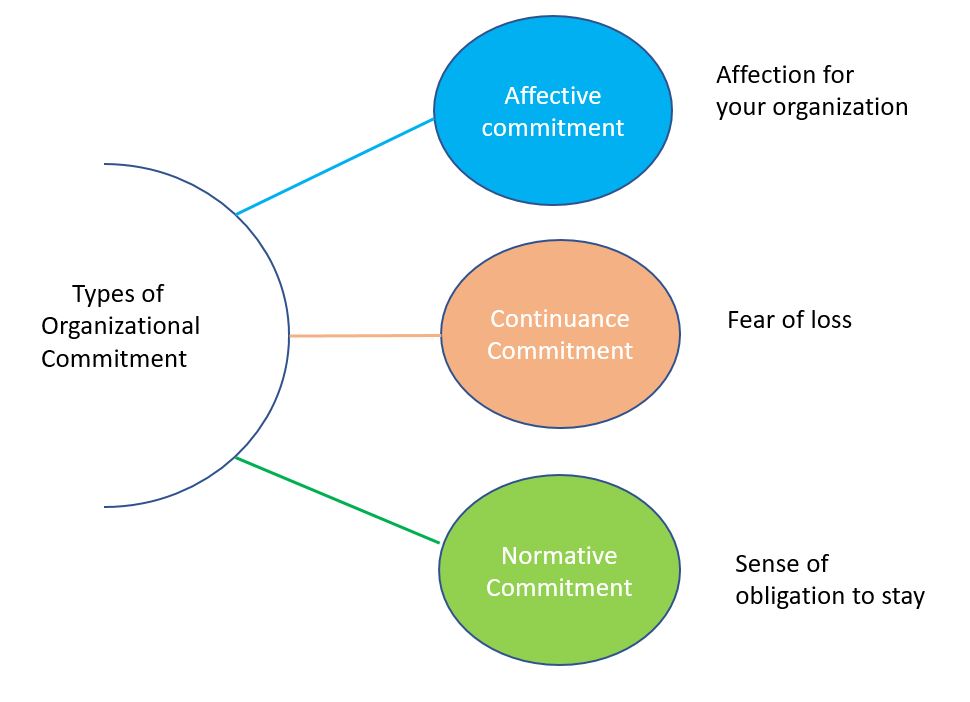
In 1991, Meyer and Allen proposed the first model of commitment consisting of three components – the Three Component Model (TCM) – each of which corresponds to a different psychological state.
The three components are:
- Affection for your organization (affective commitment).
- Fear of loss (continuance commitment).
- Sense of obligation to stay (normative commitment).
Affective commitment
In the Affective Commitment state, an employee demonstrates a high level of active commitment to the organization. They’re happy, engaged, participate in meetings and discussions, and offer valuable input and suggestions. They do all of this because they want to and strive to be an integral part of the organization.
The chances of an employee at this stage remaining with the organization for a considerable time are high.
Continuance commitment
Continuance commitment is when an employee weighs up the pros of cons of staying versus leaving the organization. There’s a fear of loss at play, and their initial affection has transformed into need.
They want to remain in the organization because they believe leaving would be costly, (” I won’t get a job that will pay me as much money”)and they’ve already invested significant time and energy in it. They feel attached (both mentally and emotionally) to the organization.
The employee weighs costs such as pension accruals and friendships with co-workers against the benefits of leaving. They also consider the availability of another position elsewhere and the disruption leaving would cause on a personal level.
Normative commitment
At this stage, the employee feels a sense of obligation to stay with the organization.
Regardless of whether they’re unhappy or desire to pursue new opportunities, they believe they have a duty to stay because it’s the “right” thing to do. (“I am loyal to the company”) There could be several different reasons for this.
They think about the time and resources that have been invested in them by the organization, or family ties with the company are creating extra pressure, or the organization regularly rewards continued commitment. Another factor might be they feel they’ve been treated well by the company and fear the grass may not be greener on the other side.
Normative commitment is the final stage of organizational commitment.
Note: These three types of commitment are not mutually exclusive. You can experience all three, or two of the three, in varying degrees.
When we discuss job satisfaction it is necessary to understand the acronym EVLN – Exit, Voice, Loyalty, Neglect. The EVLN model identifies four different ways that employees respond to dissatisfaction:
- Exit. It includes leaving the organization, transferring to another work department (or unit) or trying to get away from the dissatisfying situation. It is important to understand that specific shock events (for example: major business losses, significant intergity issues with senior leaders, ethical failures) ) quickly energize employees to think about leaving the organization and engaging themselves in exit behaviour.
- Voice. This can be a constructive response. For instance, recommending ways to improve the conflict situation, or even filling formal grievances or making a coalition in order to oppose a decision.
- Loyalty. Normally, loyal professionals are employees who respond to dissatisfaction by patiently waiting. The loyal associates can suffer in silence for days, months or even years without clear problem resolution.
- Neglect. Neglect means lacking in diligence. It includes reducing work effort, paying less attention to service quality, increases in absenteeism and lateness. This type of behaviour has negative consequences for the organization.
If continued, the negative impacts related to these work behaviours are enormous: decline in productivity, which directly affects the financial performance of an organization; less innovation, which paralyzes the future of a company and puts its own survival at risk; high turnover, employees simply go through numerous organizations, never staying in one long enough to contribute anything of value; high absenteeism, employees find various ways to postpone their jobs; and impacts on family life, employees accumulate stress throughout the work day and bring this tension home.
It is important to understand that employees can use one, two or more EVLN alternatives, it depends on the person and situation. Individual values, beliefs, culture and past experience are relevant in order to define which type of behaviours employees are more susceptible to engage.
What Causes Positive Work Attitudes?
What makes you satisfied with your job and develop commitment to your company? Research shows that people pay attention to several aspects of their work environment, including how they are treated, the relationships they form with colleagues and managers, and the actual work they perform. We will now summarize the factors that show consistent relations with job satisfaction and organizational commitment.
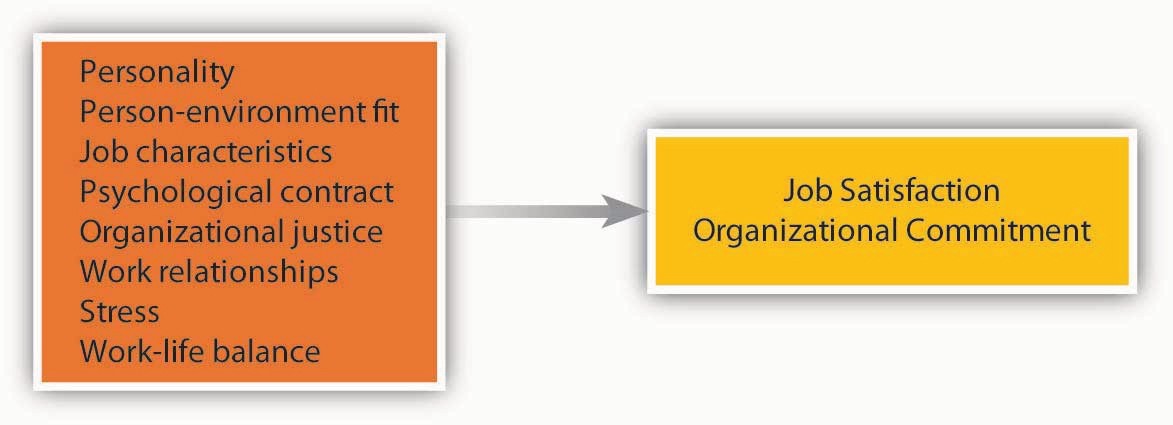
Personality
Can assessing the work environment fully explain how satisfied we are on the job? Interestingly, some experts have shown that job satisfaction is not purely environmental and is partially due to our personality. Some people have a disposition to be happy in life and at work regardless of environmental factors.
It seems that people who have a positive affective disposition (those who tend to experience positive moods more often than negative moods) tend to be more satisfied with their jobs and more committed to their companies, while those who have a negative disposition tend to be less satisfied and less committed (Connolly & Viswesvaran, 2000; Thoresen et al., 2003).
Both positive and negative attitudes affect an organization’s performance. Operations are not completely separate from employee feelings—especially when those feelings turn into actions.
This is not surprising, as people who are determined to see the glass as half full will notice the good things in their work environment, while those with the opposite character will find more things to complain about. In addition to our affective disposition, people who have a neurotic personality (those who are moody, temperamental, critical of themselves and others) are less satisfied with their job, while those who are more emotionally stable tend to be more satisfied. Other traits such as conscientiousness, self-esteem, locus of control, and extraversion are also related to positive work attitudes (Judge et al., 2002; Judge & Bono, 2001; Zimmerman, 2008). (Remember the OCEAN model in Chapter 3?). Either these people are more successful in finding jobs and companies that will make them happy and build better relationships at work, which would increase their satisfaction and commitment, or they simply see their environment as more positive—whichever the case, it seems that personality is related to work attitudes.
Person–Environment Fit

The fit between what we bring to our work environment and the environmental demands influences our work attitudes. Therefore, person–job fit and person–organization fit are positively related to job satisfaction and commitment. When our abilities match job demands and our values match company values, we tend to be more satisfied with our job and more committed to the company we work for (Kristof- Brown, Zimmerman, & Johnson, 2005; Verquer, Beehr, & Wagner, 2003).
Job Characteristics
The presence of certain characteristics on the job seems to make employees more satisfied and more committed. Using a variety of skills, having autonomy at work, receiving feedback on the job, and performing a significant task are some job characteristics that are related to satisfaction and commitment. (You will learn more about this in Chapter 6 through the Job Characteristics Model).
However, the presence of these factors is not important for everyone. Some people have a high growth need. They expect their jobs to help them build new skills and improve as an employee. These people tend to be more dependent on these characteristics for job satisfaction (Loher et al., 1985; Mathieu & Zajac, 1990).
Psychological Contract
A physical contract (appointment letter) is a tangible piece of paper or legal document which we receive upon joining an organisation. It might be different from one employee to another. The appointment letter usually includes details on where the employee should show up for work, the start date of the position, the expected work schedule and the employee’s agreed-upon salary.
Imagine that you were told before being hired that the company was family friendly and collegial. However, after a while, you realize that they expect employees to work 70 hours a week, and employees are aggressive toward each other. You are likely to experience a breach in your psychological contract and become dissatisfied. One way of preventing such problems is for companies to provide realistic job previews to their employees (Premack & Wanous, 1985; Wanous et al., 1992; Zhao et al., 2007).
After accepting a job, people come to work with a set of expectations. They understand their responsibilities and rights. In other words, they have a psychological contract with the company. A psychological contract is an unwritten understanding about what the employee will bring to the work environment and what the company will provide in exchange. When people do not get what they expect, they experience a psychological contract breach, which leads to low job satisfaction, commitment and employee turnover. That causes a hardship on the company financially. An unfilled position is costly.
And if the employee doesn’t leave the company and continues to work post contract breach – that employee will most likely not be engaged with the organization much if at all. Productivity will suffer. Team or workforce morale will take a hit. Translation other employees could be negatively impacted, and it could spread like wildfire.
Organizational Justice
A strong influence over our satisfaction level is how fairly we are treated. People pay attention to the fairness of company policies and procedures, treatment from supervisors, and pay and other rewards they receive from the company (Cohen-Charash & Spector, 2001; Colquitt et al., 2001; Meyer et al., 2002).
Relationships at Work

Two strong predictors of our happiness at work and commitment to the company are our relationships with coworkers and managers. The people we interact with, their degree of compassion, our level of social acceptance in our work group, and whether we are treated with respect are all important factors surrounding our happiness at work. Research also shows that our relationship with our manager, how considerate the manager is, and whether we build a trust-based relationship with our manager are critically important to our job satisfaction and organizational commitment (Bauer et al., 2007; Gerstner & Day, 1997; Judge, Piccolo, & Ilies, 2004; Kinicki et al., 2002; Mathieu & Zajac, 1990; Meyer et al., 2002; Rhoades & Eisenberger, 2002). When our manager and upper management listen to us, care about us, and value our opinions, we tend to feel good at work. Even small actions may show employees that the management cares about them.
Stress
Not surprisingly, the amount of stress present in our job is related to our satisfaction and commitment. For example, experiencing role ambiguity (vagueness in relation to what our responsibilities are), role conflict (facing contradictory demands at work), and organizational politics, and worrying about the security of our job are all stressors that make people dissatisfied. On the other hand, not all stress is bad. Some stressors make us happier! For example, working under time pressure and having a high degree of responsibility are stressful, but they can also be perceived as challenges and tend to be related to high levels of satisfaction (Kinicki et al., 2002; Meyer et al., 2002; Miller, Rutherford, & Kolodinsky, 2008; Podsakoff, LePine, & LePine, 2007).
Work–Life Balance
In the 1950s, people’s work was all-consuming. Employees went to work, worked long hours, and the rest of the family accepted that work came first. As society changed, the concept of always putting work first became outdated. In modern times, more employees expect to lead balanced lives, pursue hobbies, and spend more time with their children while at the same time continuing to succeed at work. The notion of work–family conflict is one cause of job dissatisfaction. This conflict can be particularly strong for women because of the time necessary for pregnancy and giving birth, but men struggle with it as well. When work life interferes with family life, we are more stressed and unhappy with our jobs. Research shows that policies that help employees achieve a balance between their work and personal lives, such as allowing telecommuting, are related to higher job satisfaction.
In a 2022 post pandemic survey by Aviva, a British multinational insurance company headquartered in London, England and a significant presence in Canada, the following were the highlights:
- More workers said they were attracted to their current role for the work-life balance (41%) than the salary (36%). This is a switch in rankings compared to 2019, before the pandemic.
- Almost 9 in 10 (88%) employees said workplace benefits (other than salary) improve their overall happiness.
- Nearly 9 in 10 employees (87%) said they want to see improvements to their workplace benefits package over the next 12 months.
Laura Stewart-Smith, Head of Financial Wellbeing at Aviva: “Before the pandemic, it would have been difficult to imagine a time when employees would pick a role for the work-life balance over the salary. The pandemic seems to have shone a light on the importance of being able to juggle family-life, exercise-life, dog-life – whatever the lifestyle – with work-life. Getting this balance right for employees and employers is a tricky one but if successfully achieved it can often mean a happier and more productive workplace.”
Consequences of Positive Work Attitudes
Why do we care about the job satisfaction and organizational commitment of employees? What behaviours would you expect to see from someone who has more positive work attitudes?
If you say, “higher performance,” you have stumbled upon one of the most controversial subjects in organizational behaviour. Many studies have been devoted to understanding whether happy employees are more productive. Some studies show weak correlations between satisfaction and performance (meaning that if an employee is very satisfied, then he/she may not be a very high performer) while others show higher correlations (what researchers would call “medium-sized” correlations of 0.30) (Iaffaldano & Muchinsky, 1985; Judge et al., 2001; Petty, McGee, & Cavender, 1984; Riketta, 2008). The correlation between commitment and performance tends to be even weaker (Mathieu & Zajac, 1990; Riketta, 2002; Wright & Bonnett, 2002). Even with a correlation of 0.30, the relationship may be lower than you may have expected. Why is this so?

It seems that happy workers have an inclination to be more engaged at work. They may want to perform better. They may be more motivated. But there are also exceptions. Think about this: just because you want to perform, will you actually be a higher performer? Chances are that your skill level in performing the job will matter. There are also some jobs where performance depends on factors beyond an employee’s control, such as the pace of the machine they are working on. Because of this reason, in professional jobs such as engineering and research, we see a higher link between work attitudes and performance, as opposed to manual jobs such as assembly line work (Riketta, 2002). Also, think about the alternative possibility: if you don’t like your job, does this mean that you will reduce your performance? Maybe up to a certain point, but there will be factors that prevent you from reducing your performance: the fear of getting fired, the desire to get a promotion so that you can get out of the job that you dislike so much, or your professional work ethic. As a result, we should not expect a one-to-one relationship between satisfaction and performance. Still, the observed correlation between work attitudes and performance is important and has practical value.
4.3 Work Behaviours
 One of the important objectives of the field of organizational behaviour is to understand why people behave the way they do. Which behaviours are we referring to here? We will focus on four key work behaviours: job performance, organizational citizenship behaviours, absenteeism, and turnover. These are not the only behaviours OB is concerned with, but understanding these key behaviours and the major influences over each will give you more clarity on how to analyze other workplace behaviours. We summarized the major research findings about the causes of each type of behaviour in the following figure.
One of the important objectives of the field of organizational behaviour is to understand why people behave the way they do. Which behaviours are we referring to here? We will focus on four key work behaviours: job performance, organizational citizenship behaviours, absenteeism, and turnover. These are not the only behaviours OB is concerned with, but understanding these key behaviours and the major influences over each will give you more clarity on how to analyze other workplace behaviours. We summarized the major research findings about the causes of each type of behaviour in the following figure.
Job Performance
Job performance, or in-role performance, refers to the performance level on factors included in the job description. For each job, the content of job performance may differ. Measures of job performance include the quality and quantity of work performed by the employee, the accuracy and speed with which the job is performed, and the overall effectiveness of the person performing the job. In many companies, job performance determines whether a person is promoted, rewarded with pay raises, given additional responsibilities, or fired from the job. Therefore, job performance is tracked and observed in many organizations and is one of the main outcomes studied in the field of organizational behaviour.
What Are the Major Predictors of Job Performance?
Under which conditions do people perform well, and what are the characteristics of high performers? These questions receive a lot of research attention.
It seems that the most powerful influence over our job performance is our (1) general mental ability, or cognitive abilities. Our reasoning abilities, verbal and numerical skills, analytical skills, and overall intelligence level seems to be important across most situations. It seems that general mental ability starts influencing us early in life; it is strongly correlated with measures of academic success (Kuncel, Hezlett, & Ones, 2004). As we grow and mature, cognitive ability is also correlated with different measures of job performance (Bertua, Anderson, & Salgado, 2005; Kuncel, Hezlett, & Ones, 2004; Salgado et al., 2003; Schmidt & Hunter, 2004; Vinchur et al., 1998). General mental ability is important for job performance across different settings, but there is also variation. In jobs with high complexity, it is much more critical to have high general mental abilities. In jobs such as working in sales, management, engineering, or other professional areas, this ability is much more important. Whereas for jobs involving manual labor or clerical work, the importance of high mental abilities for high performance is weaker, yet still important.
(2)How we are treated within an organization is another factor determining our performance level. When we feel that we are being treated fairly by a company, have a good relationship with our manager, have a manager who is supportive and rewards high performance, and we trust the people we work with, we tend to perform better. Why? It seems that when we are treated well, we want to reciprocate. Therefore, when we are treated well, we treat the company well by performing our job more effectively (Colquitt et al., 2001; Colquitt, Scott, & LePine, 2007; Podsakoff, MacKenzie, & Bommer, 1996).
Following the quality of treatment, (3) the stress we experience determines our performance level. When we experience high levels of stress, our mental energies are drained. Instead of focusing on the task at hand, we start concentrating on the stressor and become distracted trying to cope with it. Because our attention and energies are diverted to deal with stress, our performance suffers. Having role ambiguity and experiencing conflicting role demands are related to lower performance (Gilboa et al., 2008). Stress that prevents us from doing our jobs does not have to be related to our experiences at work. For example, according to a survey conducted by Workplace Options, 45% of the respondents said that financial stress affects work performance. When people are in debt, worrying about mortgage or tuition payments, or having trouble paying for essentials such as gas and food, their performance suffers (Financial stress, 2008).
(4) Our work attitudes, specifically job satisfaction, are moderate correlations to job performance. When we are satisfied with the job, we may perform better. This relationship seems to exist in jobs with greater levels of complexity and weakens in simpler and less complicated jobs. It is possible that in less complex jobs, our performance depends more on the machinery we work with or organizational rules and regulations. In other words, people may have less leeway to reduce performance in these jobs. Also, in some jobs people do not reduce their performance even when dissatisfied. For example, among nurses there seems to be a weak correlation between satisfaction and performance. Even when they are unhappy, nurses put substantial effort into their work, likely because they feel a moral obligation to help their patients (Judge et al., 2001).
Organizational Citizenship Behaviours

While job performance refers to the performance of duties listed in one’s job description, organizational citizenship behaviours involve performing behaviours that are more discretionary.
We all know an employee who always goes the extra mile, right? That one person who goes above and beyond for their co-workers and the company. They may not even know it themselves, but what they’re demonstrating is called organizational citizenship behavior.
Organizational citizenship behaviours (OCB) are voluntary behaviours employees perform to help others and benefit the organization. Helping a new co-worker understand how things work in your company, volunteering to organize the company picnic, and providing suggestions to management about how to improve business processes are some examples of citizenship behaviours. These behaviours contribute to the smooth operation of business.
What are the major predictors of citizenship behaviours? Unlike performance, citizenship behaviours do not depend so much on one’s abilities. Job performance, to a large extent, depends on our general mental abilities. When you add the education, skills, knowledge, and abilities that are needed to perform well, the role of motivation in performance becomes more limited. As a result, a motivated individual will not necessarily translate into a person performing well. For citizenship behaviours, the motivation-behaviour link is clearer. We help others around us if we feel motivated to do so.
Benefits of OCB
We’ve already mentioned a few benefits of organizational citizenship behavior above, but here is a (non-exhaustive) overview:
- OCB can boost employee morale
- It increases people’s levels of work meaningfulness. OCB allows employees to feel more control over their activities, as well as feel good about helping others. Both these components could lead people to experience work meaningfulness.
- It is good for employee performance and productivity; in fact, research shows that OCB positively predicts performance
- It creates better social interactions between employees
- It reduces stress
- It creates a sense of community among employees
- It is good for your Employer Brand
Absenteeism
Absenteeism refers to unscheduled absences from work.
When employees are habitually absent from work without good reason, that’s absenteeism. Authorized absences — scheduled vacations and family emergencies, for example — don’t count as absenteeism. Absenteeism is easy to spot because employees aren’t physically present in the office.
Example #1: Peter suffers from depression, but he doesn’t recognize the symptoms. Frequently tired and feeling generally demoralized, he regularly calls in sick.
Example #2: Aman’s colleague, Steve, often criticizes his performance at work and makes unwanted advances when his line manager isn’t on site. Feeling intimidated, he stays away from the office.
Absenteeism is costly to companies because of its unpredictable nature. When an employee has an unscheduled absence from work, companies struggle to find replacement workers at the last minute. This may involve hiring contingent workers, having other employees work overtime, or scrambling to cover for an absent co-worker.

What causes absenteeism? First, we need to look at the types of absenteeism. Some absenteeism is unavoidable and is related to health reasons. For example, reasons such as lower back pain, migraines, accidents on or off the job, or acute stress are important reasons for absenteeism (Farrell & Stamm, 1988; Martocchio, Harrison, & Berkson, 2000). Health-related absenteeism is costly but dealing with such absenteeism by using organizational policies penalizing absenteeism is both unreasonable and unfair. A sick employee who shows up at work will infect coworkers and will not be productive. Instead, companies are finding that programs aimed at keeping workers healthy are effective in dealing with this type of absenteeism. Companies using wellness programs that educate employees about proper nutrition, help increase exercise, and reward them for healthy habits are related to reduced absenteeism (Parks & Steelman, 2008).
Presenteeism
When employees are present but not productive, that’s presenteeism. Instead of completing tasks efficiently, they stare into space, chat, browse the internet or take extended breaks away from their desks. Presenteeism is more difficult to define than absenteeism: employees are physically there, but they’re mentally unengaged.
Example #1: Margarita has been ill for a while, but she doesn’t have any more sick days and she can’t afford to take unpaid time off. She attends work, but her performance is subpar.
Example #2: Prashant is the most experienced attorney at his firm. He has the flu, but he comes into work anyway because he isn’t comfortable handing off cases to his colleagues. Prashant is unable to give of his best.
Turnover
Turnover refers to an employee leaving an organization. Employee turnover has potentially harmful consequences, such as poor customer service and poor companywide performance. When employees leave, their jobs still need to be performed by someone, so companies spend time recruiting, hiring, and training new employees, all the while suffering from lower productivity. Yet, not all turnover is bad. Turnover is particularly a problem when high-performing employees leave, while a poor performer’s turnover may actually give the company a chance to improve productivity and morale.

Why do employees leave? An employee’s performance level is an important reason. People who perform poorly are actually more likely to leave. These people may be fired or be encouraged to quit, or they may quit because of their fear of being fired. If a company has pay-for-performance systems, poor performers will find that they are not earning much, owing to their substandard performance. This pay discrepancy gives poor performers an extra incentive to leave. On the other hand, instituting a pay-for-performance system does not mean that high performers will always stay with a company. Note that high performers may find it easier to find alternative jobs, so when they are unhappy, they can afford to quit their jobs voluntarily (Williams & Livingstone, 1994).
Work attitudes are often the primary culprit in why people leave. When workers are unhappy at work, and when they are not attached to their companies, they are more likely to leave. Loving the things they do, being happy with the opportunities for advancement within the company, and being happy about pay are all aspects of work attitudes relating to turnover. Of course, the link between work attitudes and turnover is not direct. When employees are unhappy, they might have the intention to leave and may start looking for a job, but their ability to actually leave will depend on many factors such as their employability and the condition of the job market.
A Pew research report highlighted that the COVID-19 pandemic set off nearly unprecedented churn in the U.S. labor market. Widespread job losses in the early months of the pandemic gave way to tight labor markets in 2021, driven in part by what’s come to be known as the Great Resignation. The nation’s “quit rate” reached a 20-year high in November 2021.
Majorities of workers who quit a job in 2021 say low pay (63%), no opportunities for advancement (63%) and feeling disrespected at work (57%) were reasons why they quit.
Roughly half say child care issues were a reason they quit a job (48% among those with a child younger than 18 in the household). A similar share point to a lack of flexibility to choose when they put in their hours (45%) or not having good benefits such as health insurance and paid time off (43%).
4.4 Conclusion
Work attitudes are our feelings toward our company and job. Job satisfaction and organizational commitment are related to many outcomes of interest, such as absenteeism, performance, and turnover. Therefore, companies track feelings toward work and try to create more positive attitudes. The main behaviours that contribute to organizational effectiveness are job performance, citizenship behaviours, absenteeism, and turnover. These behaviours are affected by a complex blend of personality and situational factors, and factors affecting these behaviours and work attitudes will be examined in more detail in other chapters of this book.

